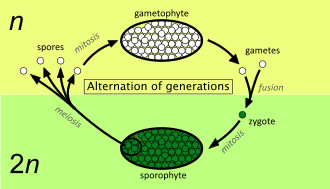Alternation of generations





Alternation of generations is a significant biological process observed in the life cycles of many plants, algae, and some fungi and protists. This phenomenon is characterized by the cyclic alternation between two distinct forms in the life cycle of an organism: the haploid phase, known as the gametophyte, and the diploid phase, known as the sporophyte. Each phase produces the other through different types of reproductive processes, ensuring the continuation of the species.
Overview[edit]
The concept of alternation of generations highlights the diversity in the reproductive strategies of organisms. In this process, the gametophyte phase produces gametes (sperm and eggs) through mitosis, which, upon fertilization, give rise to the sporophyte phase. The sporophyte, in turn, produces spores through a process called meiosis, which then develop into the gametophyte generation. This cycle allows for both sexual and asexual reproduction, contributing to genetic diversity and adaptability of species.
Types of Alternation of Generations[edit]
There are mainly two types of alternation of generations observed in nature: haplontic and diplontic, with a third type, haplodiplontic, combining aspects of both.
Haplontic Life Cycle[edit]
In the haplontic life cycle, the dominant life stage is the haploid gametophyte, with the diploid sporophyte being transient or reduced. This type is commonly found in many algae and some fungi.
Diplontic Life Cycle[edit]
The diplontic life cycle features a dominant diploid sporophyte stage, with the gametophyte being reduced or even microscopic in size. This pattern is typical in most seed plants and some algae.
Haplodiplontic Life Cycle[edit]
The haplodiplontic life cycle, also known as the alternation of generations, involves both the gametophyte and sporophyte stages being multicellular and often independent. This type is observed in bryophytes (mosses, liverworts, and hornworts), ferns, and some algae.
Ecological and Evolutionary Significance[edit]
The alternation of generations has significant ecological and evolutionary implications. It allows organisms to exploit different ecological niches and conditions, enhancing survival and adaptability. The genetic variation introduced through sexual reproduction in the gametophyte phase contributes to the evolutionary potential of species, enabling them to respond to environmental changes and pressures.
Conclusion[edit]
Alternation of generations is a fascinating aspect of the life cycles of many organisms, illustrating the complexity and diversity of reproductive strategies in nature. It underscores the interconnectedness of life forms and their environments, playing a crucial role in the survival, adaptability, and evolution of species.

Ad. Transform your life with W8MD's Budget GLP-1 injections from $75


W8MD offers a medical weight loss program to lose weight in Philadelphia. Our physician-supervised medical weight loss provides:
- Weight loss injections in NYC (generic and brand names):
- Zepbound / Mounjaro, Wegovy / Ozempic, Saxenda
- Most insurances accepted or discounted self-pay rates. We will obtain insurance prior authorizations if needed.
- Generic GLP1 weight loss injections from $75 for the starting dose.
- Also offer prescription weight loss medications including Phentermine, Qsymia, Diethylpropion, Contrave etc.
NYC weight loss doctor appointmentsNYC weight loss doctor appointments
Start your NYC weight loss journey today at our NYC medical weight loss and Philadelphia medical weight loss clinics.
- Call 718-946-5500 to lose weight in NYC or for medical weight loss in Philadelphia 215-676-2334.
- Tags:NYC medical weight loss, Philadelphia lose weight Zepbound NYC, Budget GLP1 weight loss injections, Wegovy Philadelphia, Wegovy NYC, Philadelphia medical weight loss, Brookly weight loss and Wegovy NYC
|
WikiMD's Wellness Encyclopedia |
| Let Food Be Thy Medicine Medicine Thy Food - Hippocrates |
Medical Disclaimer: WikiMD is not a substitute for professional medical advice. The information on WikiMD is provided as an information resource only, may be incorrect, outdated or misleading, and is not to be used or relied on for any diagnostic or treatment purposes. Please consult your health care provider before making any healthcare decisions or for guidance about a specific medical condition. WikiMD expressly disclaims responsibility, and shall have no liability, for any damages, loss, injury, or liability whatsoever suffered as a result of your reliance on the information contained in this site. By visiting this site you agree to the foregoing terms and conditions, which may from time to time be changed or supplemented by WikiMD. If you do not agree to the foregoing terms and conditions, you should not enter or use this site. See full disclaimer.
Credits:Most images are courtesy of Wikimedia commons, and templates, categories Wikipedia, licensed under CC BY SA or similar.
Translate this page: - East Asian
中文,
日本,
한국어,
South Asian
हिन्दी,
தமிழ்,
తెలుగు,
Urdu,
ಕನ್ನಡ,
Southeast Asian
Indonesian,
Vietnamese,
Thai,
မြန်မာဘာသာ,
বাংলা
European
español,
Deutsch,
français,
Greek,
português do Brasil,
polski,
română,
русский,
Nederlands,
norsk,
svenska,
suomi,
Italian
Middle Eastern & African
عربى,
Turkish,
Persian,
Hebrew,
Afrikaans,
isiZulu,
Kiswahili,
Other
Bulgarian,
Hungarian,
Czech,
Swedish,
മലയാളം,
मराठी,
ਪੰਜਾਬੀ,
ગુજરાતી,
Portuguese,
Ukrainian